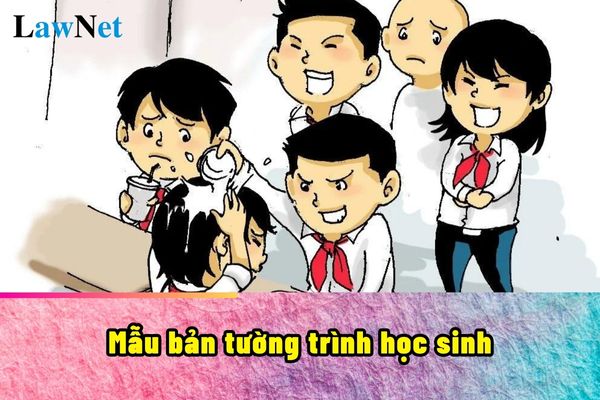What is the sample Form of a lower secondary school student's written explanation in Vietnam?
What is the sample Form of a lower secondary school student's written explanation in Vietnam?
The student's written explanation is a type of document used when a student violates school rules or regulations or when an incident occurs that requires clarification. This explanation plays an important role in verifying events, clarifying causes, and proposing appropriate disciplinary actions.
|
Sample Written Explanation (for reference) - National Emblem, Motto (centered); REPORT Regarding: ................................................................................................................ How to Write * Introduction: |
*Note: Information is for reference only./.
>>> Download the sample Form of a lower secondary school student's written explanation.

What is the sample Form of a lower secondary school student's written explanation in Vietnam? (Image from Internet)
What are the duties and rights of secondary school students in Vietnam?
According to the provisions in Articles 34 and 35 of the Charter issued with Circular 32/2020/TT-BGDDT, secondary school students have the following duties and rights:
(1) Duties:
- Undertake learning and training tasks according to the school's education program and plans.
- Respect parents, staff, teachers, school employees, and older people; unite and assist each other in studying and training; follow the school's charter and rules; comply with state laws.
- Exercise and maintain personal hygiene.
- Participate in collective activities of the school, class, Ho Chi Minh Young Pioneers Organization, Ho Chi Minh Communist Youth Union; help families, participate in labor and social activities, environmental protection activities, and observe traffic safety regulations.
- Preserve and protect school and public property; contribute to building, protecting, and promoting the school's traditions.
(2) Rights:
- Be equally entitled to comprehensive education, guaranteed conditions for time, facilities, hygiene, and safety for studying in class and at home, provided with information about their learning and training, using equipment and facilities for studying, cultural, and sports activities as per regulations.
- Be respected and protected, treated equally and democratically, have the right to appeal to the school and educational management levels regarding decisions affecting them; the right to transfer schools for valid reasons per current regulations; advance grade, accelerate learning, and study at an older age as specified in Article 33 of the Charter issued with Circular 32/2020/TT-BGDDT.
- Participate in activities to develop talents in subjects, sports, and arts organized by the school if conditions are met.
- Receive scholarships or other supports according to policies for socially supported students, students with livelihood difficulties, and talented students.
- Transfer schools if eligible per regulations; the transfer procedures follow the provisions of the Minister of Education and Training.
- Enjoy other rights as prescribed by law.
What are the responsibilities of the principal in assessing secondary school students in Vietnam?
Based on Article 18 Circular 22/2021/TT-BGDDT, the responsibilities of the principal are as follows:
Principal Responsibilities
1. Manage, guide teachers, staff, students, and disseminate the regulations of this Circular to parents.
2. Organize the implementation of student assessment according to this Circular at the educational institution; direct, inspect, and supervise regular, periodic assessments by teachers; monthly record comments and sign confirmations in the class monitoring and evaluation book.
3. Inspect and evaluate the recording results in class monitoring and evaluation books (by class), teachers' monitoring and evaluation books, student report books of subject teachers, and homeroom teachers; approve amendments to points, modifications of subject evaluations by subject teachers after confirmation by homeroom teachers.
4. Organize re-evaluation of subjects according to Article 14 of this Circular; approve and announce the list of students advancing to the next grade after re-evaluation results of subjects and summer training results.
5. Review the list of students advancing to the next grade, re-evaluating subjects, training during summer, not advancing to the next grade, and awards. Approve student evaluation results in the class monitoring and evaluation books and student report books after all subject teachers and homeroom teachers have fully recorded content.
Therefore, in managing the monitoring and evaluation of secondary school students, the principal has the following responsibilities:
- Monthly record comments and sign confirmations in the class monitoring and evaluation book.
- Inspect and evaluate the recording results in class monitoring and evaluation books (by class), teachers' monitoring and evaluation books.
- Approve student evaluation results in the class monitoring and evaluation book.

